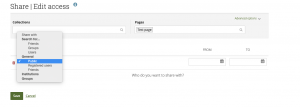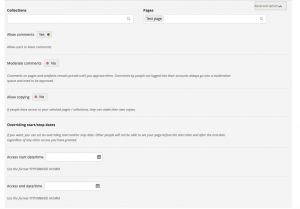Creating digital portfolios
By Samantha Ahern, on 7 November 2019
In the last few years I have used a number of online tools to create digital portfolios as part of my continuing professional development, both HEA Fellowship and Associate CMALT.
For these portfolios I have used both MyPortfolio (Mahara) and Reflect (WordPress).
Both do the job well, but there are differences in the development process and how you approach the development of the portfolio. You are welcome to view the portfolio I created for HEA Fellowship, original MyPortfolio pages and/or Reflect portfolio.
MyPortfolio
MyPortfolio is UCL’s version of Mahara, an eportfolio development tool. Portfolios are created via pages that are linked together as collections.
When you create your pages you have control over the structural layout. You choose from the inbuilt layout options, or you can create your own by selecting the number of rows, then the number of columns for each row and the page width percentage allocated to each column.
This gives you almost total control of the positioning of objects on the page. Any type of object can be added to any of the ‘content boxes’ you have created.
However, you are limited with regards to the look and feel of the pages. You can select from a number of Skins, but these only change the surrounds of the main content. You cannot change the background colour of the background boxes themselves.
You do however, have quite granular control over who can view your pages and collections. By default, only you can view your pages. This is good while developing your portfolio if you’re not keen on anyone seeing your work in progress. When you are ready to share your work, you can decide who you want to share with and for how long, a set time period or indefinitely.
There are also advanced options where you can modify the settings relating to comments and copying of your pages.
Reflect
Reflect is UCL’s blogging service for staff and students. Its primary use is for teaching and learning purposes. It is a WordPress platform provided by CampusPress. For this reason it is not possible to use the WordPress app with Reflect sites.
First and foremost WordPress is a blogging a platform, and this makes it a great tool for reflection and journalling. However, for creating portfolios it is best to make use of pages. You can set a page, as the main first page of your Reflect site giving it the appearance of a website as opposed to a blog.
In WordPress, appearance and layout is determined by the Theme that you have chosen, and will apply to all of your site. You cannot have different themes for different sections. It is therefore imperative that you choose an appropriate them for your site. Think carefully about what you are trying to achieve and the type of content (e.g. text, images and video) that you wish to include.
At present there are over 400 themes available for Reflect. For most sites I would recommend selecting one of themes identified as Accessibility Ready, this will help more users access your content.
However, for portfolios I recommend choosing one of the Portfolio themes and one that best matches the mix of content you expect to include. Themes can easily be changed, so you may need to experiment with a few to find a good match.
Once you have chosen your theme, make use of the menu builder and pages to create the structure for your portfolio. You can group content using parent and child pages.
Pages can be saved as Drafts whilst they are still in development, however they need to be published before they can be added to the menu.
By default Reflect does not have the granularity of access control that MyPortfolio has. However, if you activate the “User Specific Content” plugin you can specify who can see what pages. Otherwise, your site is private or public.
Employability and Connected Curriculum
Both MyPortfolio and Reflect are great tools for Connected Curriculum activities where students are required to create content for an external audience. However, if you are looking to enhance students’ employability skills, I recommend the use of Reflect as WordPress is used widely. In 2015, 25% of all websites used WordPress (https://w3techs.com/) and its market share has continued to grow and is currently used for 84% of all Japanese websites.
 Close
Close








